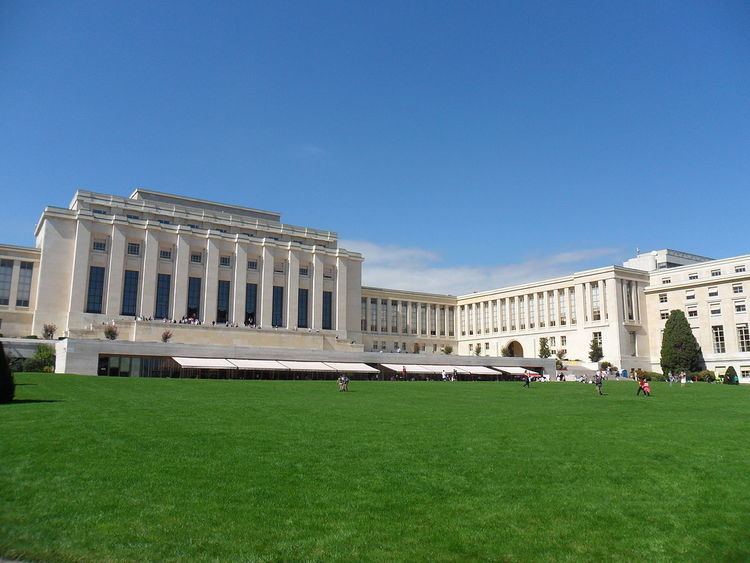Architectural style Classicism Completed 1938 Floor area 17.635m Opened 1938 | Renovated planned 2017–2023 Phone +41 22 917 12 34 Construction started 7 September 1929 | |
 | ||
Hours Open today · 10AM–12PM, 2–4PMTuesday10AM–12PM, 2–4PMWednesday10AM–12PM, 2–4PMThursday10AM–12PM, 2–4PMFriday10AM–12PM, 2–4PMSaturdayClosedSundayClosedMonday10AM–12PM, 2–4PMSuggest an edit Similar Jet d'Eau, L'horloge fleurie, St Pierre Cathedral, International Red Cross and Red, Musée Ariana | ||
Chinese president delivers a speech at the palace of nations
The Palace of Nations (French: Palais des Nations, [palɛ de nɑsjɔ̃]) in Geneva, Switzerland, was built between 1929 and 1938 to serve as the headquarters of the League of Nations. It has served as the home of the United Nations Office at Geneva since 1946 when the Secretary-General of the United Nations signed a Headquarters Agreement with the Swiss authorities, although Switzerland did not become a member of the United Nations until 2002.
Contents
- Chinese president delivers a speech at the palace of nations
- Unog chief takes you on a walk around the palace of nations
- History
- Description
- References
In 2012 alone, the Palace of Nations hosted more than 10,000 intergovernmental meetings.
Unog chief takes you on a walk around the palace of nations
History
An architectural competition held in the 1920s to choose a design for the complex described the project as follows:
The Palace, whose construction is the object of the competition, is intended to house all the organs of the League of Nations in Geneva. It should be designed in such a way as to allow these organs to work, to preside and to hold discussions, independently and easily in the calm atmosphere which should prevail when dealing with problems of an international dimension.
A jury of architects was selected to choose a final design from among three-hundred and thirty-seven entries but was unable to decide on a winner. Ultimately, the five architects behind the leading entries were chosen to collaborate on a final design: Julien Flegenheimer of Switzerland, Camille Lefèvre and Henri-Paul Nénot of France, Carlo Broggi of Italy and József Vágó of Hungary. Donations from League members were used in the interior. The Palace constituted at the time of completion (1936), volume wise, the second-largest building complex in Europe after Versailles (440,000 m3 (15,500,000 cu ft) vs. 460,000 m3 (16,200,000 cu ft) ). After its transfer to the United Nations, two extensions were added to the building, which considerably increased the size of the usable area of the building. Between 1950-1952, three floors were added to the "K" building, and the "D" building was constructed to house temporarily the World Health Organization. The "E" building (or "New" Building) was added between 1968-1973 as a conference facility (an additional eleven conference rooms and an extra volume of 380,000 m3 (13,400,000 cu ft)), with bringing the total of conference rooms to 34. With the additions, the complex is 600 metres (2,000 ft) long and holds 2,800 offices, with a total volume of 853,000 m3 (30,100,000 cu ft)
In December, 1988, in order to hear Yasser Arafat, the United Nations General Assembly moved its 29th session from the United Nations Headquarters in New York to the Palace of Nations.
Description
The Palace is located in Ariana Park, which was bequeathed to the City of Geneva in 1890 by Gustave de Revilliod de la Rive, on several conditions: i.a. that the park always remain accessible to the public and that he be buried in the park. The park also contains a 1668 chalet.
Beneath the Palace of Nations's foundation stone is a time capsule containing a document listing the names of the League of Nations member states, a copy of the Covenant of the League, and specimen coins of all the countries represented at the league's Tenth Assembly. A medal showing the Palace of Nations with the Jura Mountains in the background was struck in silvered bronze.
The building overlooks Lake Geneva and has a clear view of the French Alps.
